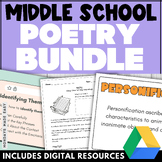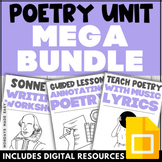Haiku Poetry Lesson - How to Write a Haiku Assignment Haiku Templates and Rubric
- Zip
- Google Apps™

What educators are saying
Also included in
- This modern middle school poetry unit will hook even your most reluctant readers! Includes introductory slideshow lessons, poetic device games and activities, poetry writing workshops, assignments, rubrics, and more. Suitable for distance learning and Google Classroom®!⚡️ Save over 30% with the bundlPrice $18.50Original Price $26.40Save $7.90
- Looking for middle school mini lessons, worksheets, handouts, and activities to teach literacy in the secondary English Language Arts classroom? This MASSIVE bundle includes reading, writing, speaking and listening activities for over 29 weeks of daily lessons, activities and literacy tasks!⚡️⚡️⚡️ OVEPrice $150.00Original Price $349.95Save $199.95
- Teach students how to write poetry using these poetry writing workshops! This poetry unit includes three writing assignments for haiku, sonnet, and free verse poetry. Includes digital worksheets for Google Classroom®!⚡️⚡️⚡️ Save over 30% with the bundled discount! ⚡️⚡️⚡️Included in this bundle:1. Free VPrice $11.00Original Price $17.25Save $6.25
- This modern high school poetry unit will hook even your most reluctant learners! This bundle provides over 300 pages of materials including slideshow lessons, vocabulary activities, poetry writing workshops, assignments, rubrics, and more. Suitable for distance learning and Google Classroom®!⚡️ SavePrice $31.00Original Price $44.30Save $13.30
Description
Teach students the history of haiku and about writing haiku poetry with this haiku poem workshop! This lesson includes haiku templates and a haiku rubric for assessment. Suitable for distance learning and Google Classroom®!
Included with this Writing Haiku Poetry Workshop:
✏️ Haiku Poetry Slideshow Lesson - Microsoft PowerPoint® and Google Slides®
✏️ Guided Note for Haiku Poetry Lesson - Digital & Print
✏️ Haiku Writing Assignment Instructions - Digital & Print
✏️ Differentiated Haiku Templates - Digital & Print
✏️ 8 Haiku Writing Prompts - Digital & Print
✏️ Editable Haiku Rubric - Digital & Print
✏️ Teacher Instructions for using this resource
How to use this Writing Haiku Poetry Workshop:
Students will learn about the history of haiku poetry and explore different haiku poems before composing their own series of 8 haiku. You can use the differentiated haiku templates and writing prompts for this assignment, as well as the haiku rubric for assessment.
You can begin this workshop with the multimedia slideshow lesson. This lesson will activate background knowledge and recall essential terminology for understanding the form of a haiku poem.
The slideshow provides a comprehensive definition of the term haiku, along with hyperlinks for videos and webpages in order to explore the history, structure, and oration of several haiku. The slideshow requires access to the internet and the videos are linked to YouTube; if your district does not allow YouTube, you can still use the internet web links to explore haiku with your students.
The slideshow lesson is provided in PDF, Microsoft PowerPoint®, and Google Drive® format; if you wish for students to work through this lesson at their own pace, you can assign them their own individual slide deck through Google Classroom®. They can type their answers directly into the slide deck.
This resource also includes a guided note along instructions for a haiku writing assignment that will have students write a series of 8 haiku. There are three different options for this assignment: students can use the writing prompts provided, or write about their own topics using the haiku poem templates. Each assignment option includes a digital slide deck for Google Drive®, along with a ready-to-print workbook.
Finally, an editable haiku rubric for this assignment has also been provided. You may wish to edit this rubric to include your own addition on this assignment (like having students illustrate their Haiku or orate to the class); in order to do so, simply make a copy of the editable rubric to your Google Drive® or manually change the rubric within each digital slide deck.
⭒ For classrooms utilizing Google Classroom® ⭒
To access the digital version of these worksheets, simply follow the instructions within the resource to copy the files directly to your Google Drive®.
❤️ See what others are saying! ❤️
Kia G.
January 11, 2023
⭐⭐⭐⭐⭐ Extremely satisfied
The Haiku lesson was used as part of a 7th grade thematic unit covering Ancient Japan. My students appreciated the practice opportunity and we ended up using the differentiated lesson where the theme was already suggested for the student. Great lesson!
Sarah P.
April 4, 2024
⭐⭐⭐⭐⭐ Extremely satisfied
This was excellent for helping my creative writing class write Haikus.
Sheena W.
February 19, 2023
⭐⭐⭐⭐⭐ Extremely satisfied
My students had a blast creating their own haikus. The differentiation options were spot on! I was able to find everything I needed in this one document.
✨ Kindly note that due to copyright restrictions, this resource is not editable. This is a common practice within the TPT marketplace in order to protect the clipartists and software providers that have authorized their intellectual property for the development of this resource.
This resource is included in Mondays Made Easy's Poetry Writing Unit - save with the bundled discount!
⭐ Customer Tip! ⭐
Want FREE CREDIT to go towards purchases? Make sure to offer feedback for your downloads! Follow these instructions below:
- Go to your "My Purchases" page to find a "Provide Feedback" button next to each download.
- Follow this link to offer a quick rating and leave a short comment for the product. Each time you give feedback, TPT gives you feedback credits that you use to lower the cost of your future purchases!
- Your feedback is important to me as it helps me to continually improve my products and ensure they are meeting your needs!
Follow me! Be the first to know about product launches, sales, discounts, and free giveaways:
➾ The Blog
For questions, collaborations, or other concerns:
✉ Contact me: hello@mondaysmadeeasy.com
Access my Free Resource Library!
Mondays Made Easy is committed to the continual improvement of resources to meet the current needs of teachers. This product was last updated on March 21, 2022.









